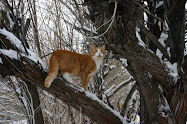11/27/2009
Short Entry from Terry
Good morning & Happy Thanksgiving. I'm going to leave Carol's blog up; I don't know for how long. I'm not sure I'll make entries, but for those of you who want to reminisce, please enjoy. There's some great content here as I'm sure you'll agree. Best to you all!
7/06/2009
6/17/2009
Fort Fred Steele in Wyoming
Ever since I read "The World Without Us", I have been fascinated by abandoned places. I wonder about the people who once were there: what brought them to often far distant and isolated places.

Fort Fred Steele is one of those places. It is 12 miles east of Rawlins. It was established in 1868 and abandoned in 1886 and sits on the bank of the North Platte River. The original fort was quite large.
This is one of two stone chimneys that once warmed the two large barracks. The last of the barracks were burned down in the 1970s during an act of arson.
I wanted to stay longer in that long lonely place, but thick storm clouds were crackling lighting and spitting rain.

Another building, possibly officers quarters with the remains of another building with a stone foundation.
 The view of the North Platte from the top of the small hill at the fort.
The view of the North Platte from the top of the small hill at the fort.
 Thousands of rocks were collected and stacked to create foundations, including a stone corral (but the weather prevented me from visiting the corral).
Thousands of rocks were collected and stacked to create foundations, including a stone corral (but the weather prevented me from visiting the corral).
 This is a far distant and isolated country. Beautiful.
This is a far distant and isolated country. Beautiful.

Fort Fred Steele is one of those places. It is 12 miles east of Rawlins. It was established in 1868 and abandoned in 1886 and sits on the bank of the North Platte River. The original fort was quite large.
This is one of two stone chimneys that once warmed the two large barracks. The last of the barracks were burned down in the 1970s during an act of arson.
I wanted to stay longer in that long lonely place, but thick storm clouds were crackling lighting and spitting rain.

Another building, possibly officers quarters with the remains of another building with a stone foundation.
 The view of the North Platte from the top of the small hill at the fort.
The view of the North Platte from the top of the small hill at the fort. Thousands of rocks were collected and stacked to create foundations, including a stone corral (but the weather prevented me from visiting the corral).
Thousands of rocks were collected and stacked to create foundations, including a stone corral (but the weather prevented me from visiting the corral). This is a far distant and isolated country. Beautiful.
This is a far distant and isolated country. Beautiful.
6/16/2009
Cottonwood at Timberlake
I love sagebrush, and I love lonely cottonwoods at the base of an empty reservoir, built by hopeful gold miners in the early part of the 20th century.


Robyn Morris, BLM archaeologist, enters coordinates on her GPS. She is standing at the top of the dam near a very deep well-like thing. If I were to write a murder mystery, this is where I'd hide the body.


Robyn Morris, BLM archaeologist, enters coordinates on her GPS. She is standing at the top of the dam near a very deep well-like thing. If I were to write a murder mystery, this is where I'd hide the body.
Sombrero Horse Drive May 2009

After four years in Craig, I finally saw the annual horse drive in Maybell.
Maybell is a small community (150 residents??) 30 miles west of Craig, and every May, for the last 40 years, Sombrero Ranch has moved its horse herd from Greystone through Sunbeam and Maybell, then east on SH 40 to their summer ranch in Big Gulch.
About 700 horses stream through Maybell; several hundred people come to see the horses. City folks pay money to do the ride with the cowboys and many have been coming to the event for years.
At the Big Gulch ranch, the horses are sorted, branded, inoculated and ridden enough to go to work on dude ranches and outdoor programs throughout Colorado.
The owners are very nice, gracious people. Queeda Mantle Walker, with her husband Rex Walker, have been in the business over 50 years. Queeda has written two lovely memoirs--"The Mantle Ranch" and "Last Ranch in Hell's Canyon", both are about Moffat County and Dinosaur National Monument and horses and sagebrush and growing up in Northwest Colorado.

It is extremely difficult for me to take pictures of horses, so this is my best effort. There are some extremely talented photographers in Moffat County that do a great job of capturing the grace and power of a big herd of multi-colored horses moving down the highway.

Finally, this is one of the buildings in Maybell that just strikes my fancy. It is across the street from the Maybell Park where lots of folks come to watch the horse drive.
Rawlins--Wyoming Territorial Prison

June 10, 2009
On a trip through Wyoming, I stopped at the Territorial Prison. It operated from 1901 to 1981. What a great tour of an aging structure. It is privately owned (I believe it is a non-profit organization) and few funds to fix it up, so it is very much like it was when it closed in 1981 with a bit of disuse over the last 20 years. Paint is peeling off the walls, the same carpet is on the floor, the cells are still the colors of the rainbow and the showers are as dark at night. Hot water wasn't piped in until 1972.
The cafeteria looks ready to sit in. Parts of the buildings are closed off because of unsafe conditions--the chapel, the gym. I visited all three cell blocks, the death house, intake, the yards and grounds. It is a very good haunted "house" in October.

The front of the Wyoming Territorial Prison in Rawlins, Wyoming.

The view from cell blocks B and C.

These are the remains of the factories--making wool cloth and other items. The water tower is a striking feature of the grounds.

Cell Block A, the original and coldest part of the prison. In later years, the inmates could paint the walls of their cells any color they wanted. Each cell held two men.

Looking out at the water tower.

One of the last gas chambers still in existence in the U.S. It was a very scary structure.

Hot water heater grill in the Death House.

The cells on Death Row, four cells (I think it was four) on the same floor as the hanging gallows and the gas chamber.
Elkhead Drive-about

May 16, 2009
We drove to the Elkhead area in Moffat and Routt counties mentioned in the New York Times article (May 2009) that describes the story of Ferry Carpenter who brought two young teachers to the area, not only to teach but because there were an abundance of young men and few women... turn of the century times. Ferry Carpenter was a lawyer and rancher with considerable influence in the area, the state, and the country through his gentle intelligence and agreeable nature.
I knew him when I was quite young and interviewed his daughter, Roz Garcia, when she was in her early nineties. We talked about her experiences as the first white woman in the area to live in a sheepwagon/camp.
The following pictures almost capture the beauty of the area. We saw sharp-tailed grouse on the road beyond Elkhead Reservoir. We saw Bears Ears mountain and the vast undulating hills of fragrant sagebrush. We passed the Elkhead Community Center where I once, when I was in high school, went to a country dance.
Finally, it is spring in this country and the roads can be treacherous when wet; this is how mud dries in the high country.





Subscribe to:
Comments (Atom)



